Vibrations in the Soul: Moe Brooker’s Sacred Paintings
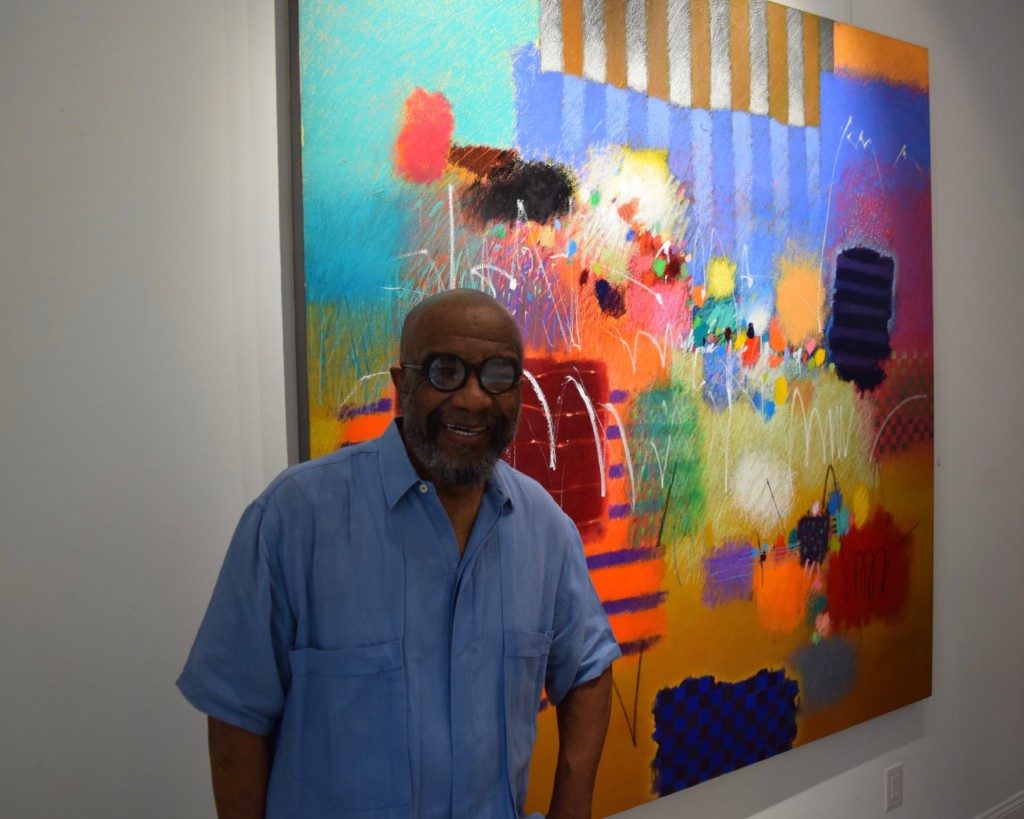
Moe A. Brooker (b. 1940) readily acknowledges his status as a “P.K.,” a preacher’s kid. Born and raised in South Philadelphia, he found his earliest artistic inspiration in the church, sketching various characters from the perspective of the pulpit: the grandmother with children, the old man who slept on the pew each week, the women with outstanding, regal church hats. Keenly aware of the sleek and brilliant wardrobes worn in the church—and on the streets of Philadelphia—he kept those animated palettes in mind when his paintings later became primarily abstract. Brooker’s faith—belief in something he cannot see—has drawn him to the influences of Henry Ossawa Tanner (1859–1937) and Wassily Kandinsky (1866–1944). As contemporaries in Europe, Tanner as an American-born artist and Kandinsky as a Russian, each artist developed spiritual theories that were manifested in new styles and experiments in painting. Furthermore, the musical innovations of jazz musicians, such as Charlie Parker, solidified Brooker’s own ambitions to push his aesthetic sensibilities. Throughout his more than four-decade-long career in the arts, Brooker has created a distinctive artistic language that calls out to viewers to not only look at his work as arrangements of patterns, colors, and shapes on canvas or paper, but also as investigations into the divine.1
Initially, Brooker believed that abstract painters were indeed “charlatans.”2 He studied at the Pennsylvania Academy of the Fine Arts (PAFA) in 1973 and later the Tyler School of Art of Temple University. He took many of his formal cues from Thomas Eakins and Robert Henri, realist painters of the late nineteenth and early twentieth centuries who had both attended the Academy. Brooker emulated their representational approaches, but he strove to paint his own experiences and those of the black community as directly as possible, which meant figural drawing and painting—one of the strengths of the school’s training even today—as featured in James (1962; fig. 2), a composition of a seated, sleeping figure within a gray interior space.3
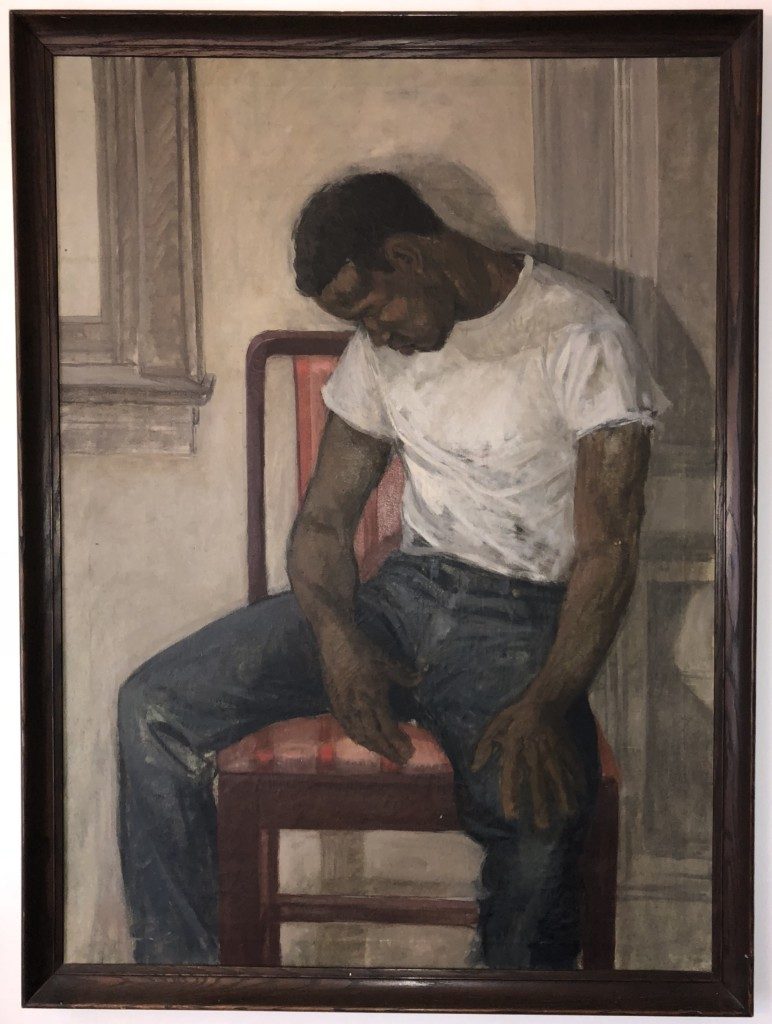
Brooker confessed that as a young artist, he most wanted to imitate one of the most venerated graduates of the school, Henry Ossawa Tanner. Tanner was born in Pittsburgh in 1859 and moved to Philadelphia as a child. Tanner entered PAFA in 1880, where he studied with Thomas Eakins. He traveled to Paris, where he entered the Académie Julian and joined the American Art Students’ Club. He also made trips to Pont-Aven on the Brittany coast, which was substantially less racist than Philadelphia. His early paintings were primarily seascapes, landscapes, and animal paintings.4
Tanner and Brooker possessed a sense of confidence in their art, which I believe arose in each of them due to their uncannily similar upbringings in Philadelphia, living in middle-class households anchored to the African Methodist Episcopal (A.M.E.) Church, although they were generations apart. Bethel African Methodist Episcopal Church, which hid many runaways since its establishment in 1793, partially contributed to the rise in the African American population in Philadelphia during the late eighteenth and early nineteenth centuries.5 What is more, Tanner was also a “P.K.,” as his father, Benjamin Tucker Tanner (1835–1923) served as a minister in the A.M.E. Church, which was founded in 1787 as the first black denomination. He held numerous, prominent roles within the church, including editor of two of the church’s national newspapers and, later, bishop.6 Brooker’s father served in the A.M.E. conference, moving from church to church throughout the greater Philadelphia region as was required throughout his tenure from the 1840s until his retirement in the 1860s. These factors matter because in the late nineteenth century, as in the twentieth, religious environments served as motivation to pursue a career in the arts as a holy calling, especially for young, African American men. In a published autobiographical essay, Tanner remarked:
It is not by accident that I have chosen to be a religious painter. . . . I paint the things I see and believe. I have no doubt an inheritance of religious feeling, and for this I am glad, but I have also a decided and I hope an intelligent religious faith not due to inheritance but to my own conviction. I believe my religion. . . . I have chosen the character of my art because it conveys my message and tells what I want to tell my own generation and leave to the future.7
In The Annunciation (1898; fig. 3), for example, a slightly surprised yet composed Mary on the right clasps her hands in resignation and expectancy as she stares attentively at a beam of light, the angel Gabriel, on the left. Tanner’s choice of imbuing the canvas with a pervasive luminescence heightens the piety and holy resignation of Mary’s fate to become the mother of God which intensifies her hallowed exchange with Gabriel. Tanner acknowledged that his religious paintings were an “inheritance of religious feeling,” but he resisted oversimplified references to his religious upbringing and his African American identity, at times. As art historian Judith Wilson points out, Tanner’s educated parents as well as his own education automatically placed him within the African American elite.8 Wilson goes on to argue that the conventional approaches of observing Tanner’s paintings have not sufficiently examined their subversive import.9 The Banjo Lesson (1893; Hampton University Museum) reflects not only Tanner’s mastery of painting as a fine artist but also, more significantly, reflects a “profound break or break-through—a declaration of African American self-esteem that anticipated the twin emphases on racial pride and vernacular culture.”10
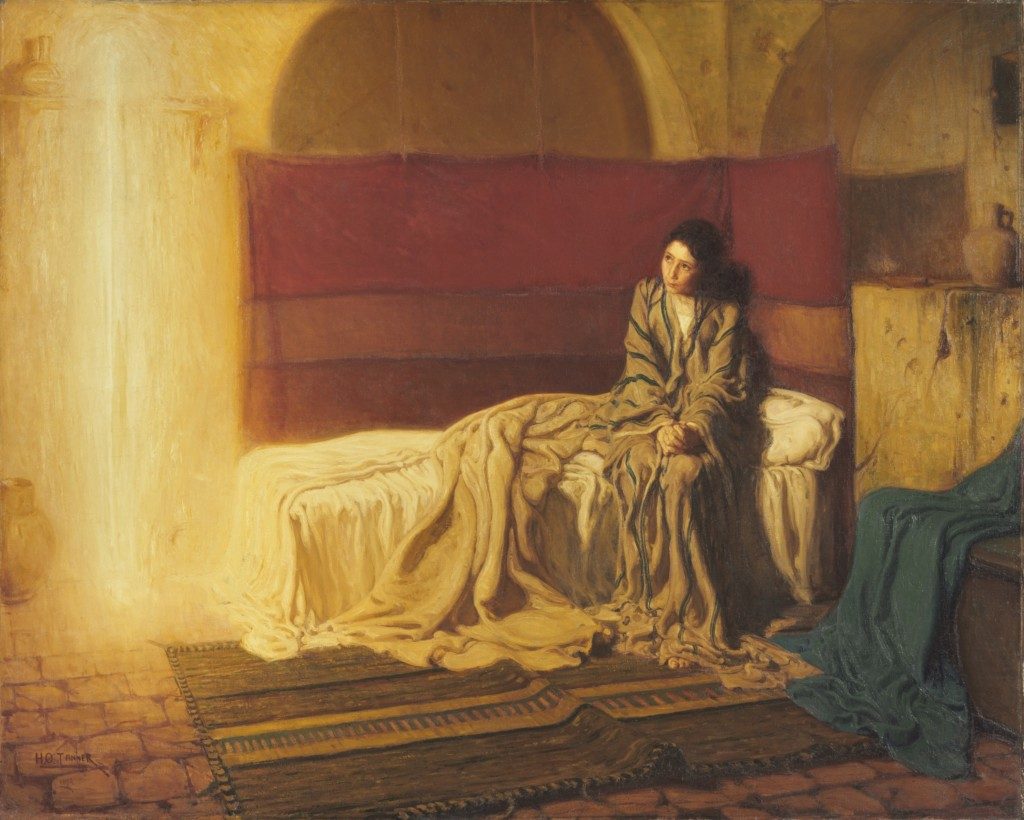
Brooker also leans heavily on his cultural heritage to inform his paintings, demonstrating his awareness and engagement with African textiles and African American quilting traditions. Brooker’s work also recalls the alternate plain-weave and inlay designs in the more than three hundred named patterns of Asante kente cloth, including the often randomly arranged chessboards and stepped diagonals.11 The chessboard, in particular, is a common pattern in much of his work, including the blue-and-black pattern in Ancient Futures I (2006; fig. 4) in the upper right-hand corner of the canvas, not to mention Kandinsky’s own use of the checkerboard (1923; fig. 5). Alternatively, Brooker credits Johannes Vermeer’s The Art of Painting (The Artist in His Studio) (c. 1665–68; Kunsthistorisches Museum, Vienna), for helping him understand how to create space, particularly in how the floors open up and direct the gaze of the viewer from the foreground into the deep recesses of the composition. Even though Tanner and Brooker produced radically different canvases, a synergy nevertheless exists between them in terms of their technical approach to painting. Tanner, like Brooker, was experimental in his layered treatment of the surface. In preparation for the revelatory exhibition at the Pennsylvania Academy of the Fine Arts in 2012, Henry Ossawa Tanner: Modern Spirit, conservationists revealed that by mid-career onward, “the artist seems to have favored far more complex mixtures of oil, resins, and his own tempera formulations.”12
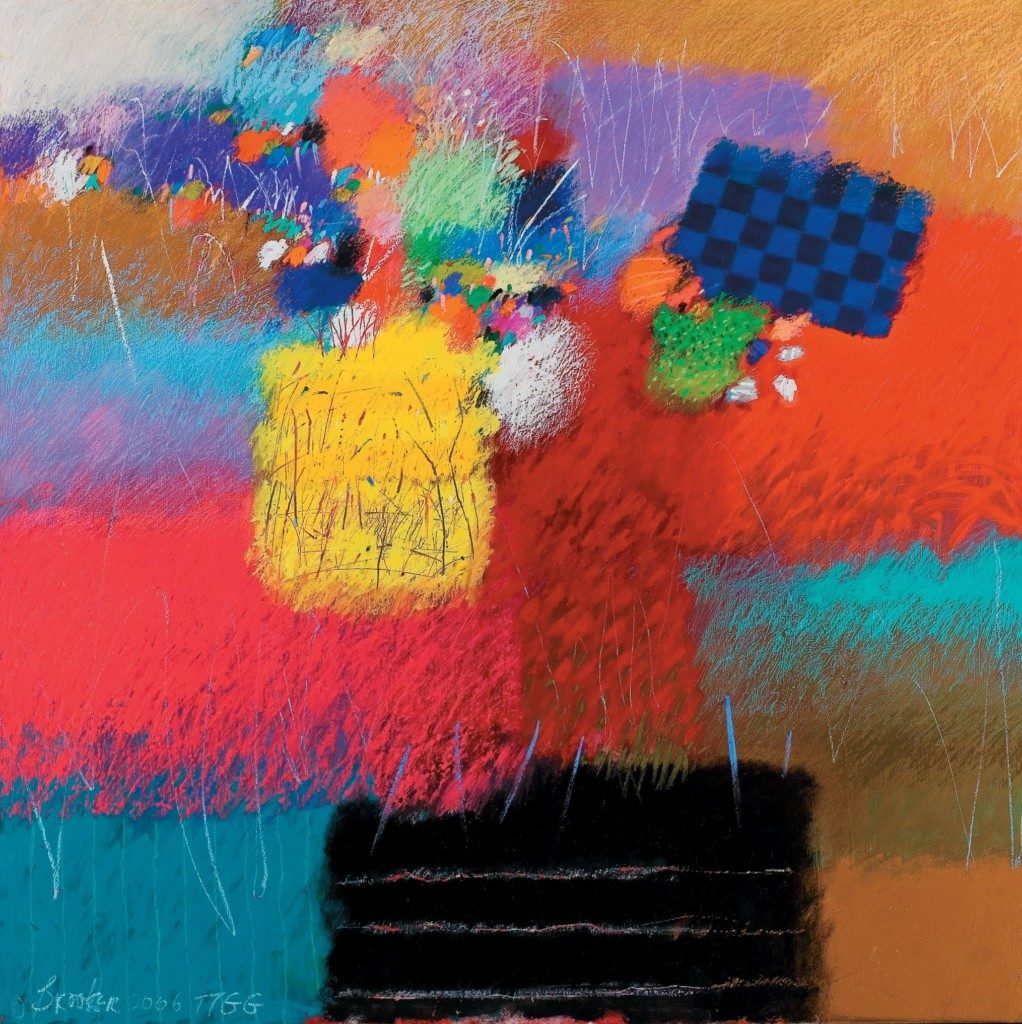
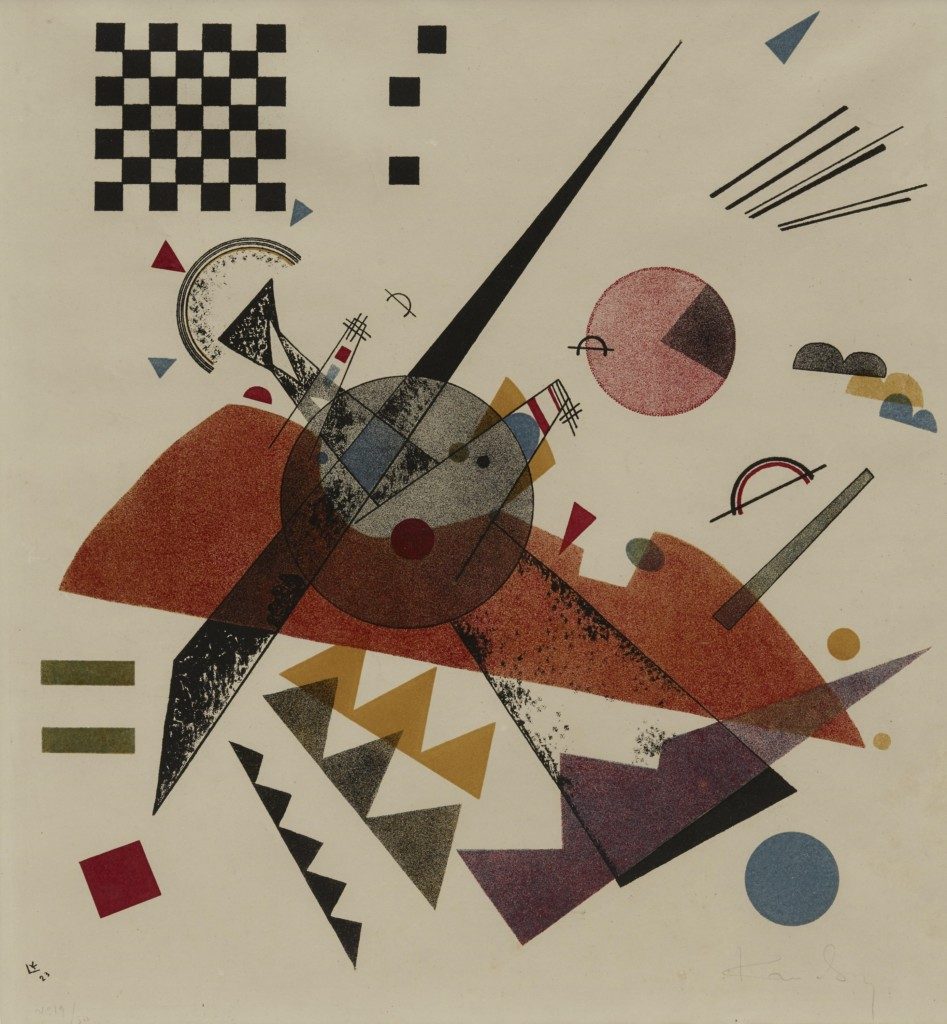
African sensibilities for color selection and skills in textile production carried over during the transatlantic slave trade. Black women, in particular, made various types of pieced textiles, patchwork, and appliqué and embroidered quilts during the antebellum and post-slavery eras. As a result, the legacy of quilts as an expressive outlet for the display of African retentions remains and thrives within some African American communities.13 Most notably, the quilts produced by women from Gee’s Bend, Alabama, have received much attention, with several traveling exhibitions throughout the country over the last twenty years, including the one that Brooker viewed, Gee’s Bend: The Architecture of the Quilt, at the Philadelphia Museum of Art during the fall of 2008.14 Evidence of the collage-like quality of combining overlapping fields of color in distinctive shapes and varying sizes appeared in Brooker’s work long before he had ever laid eyes on the quilts of Gee’s Bend or on quilts such as the pieced and appliqué quilt made by Marie Hensley (1870–1932) from McDowell County, North Carolina (early 20th century; fig. 6). Nevertheless, when questioned about how southern women’s quilt-making practices affected him, he acknowledges that their quilts reflect the same type of intuitive “African choice system of color and shape.”15 In Ancient Futures I, Brooker anchors the background with a patchwork quality of large rectangles of vibrant hues of orange, red, green, blue, and black.
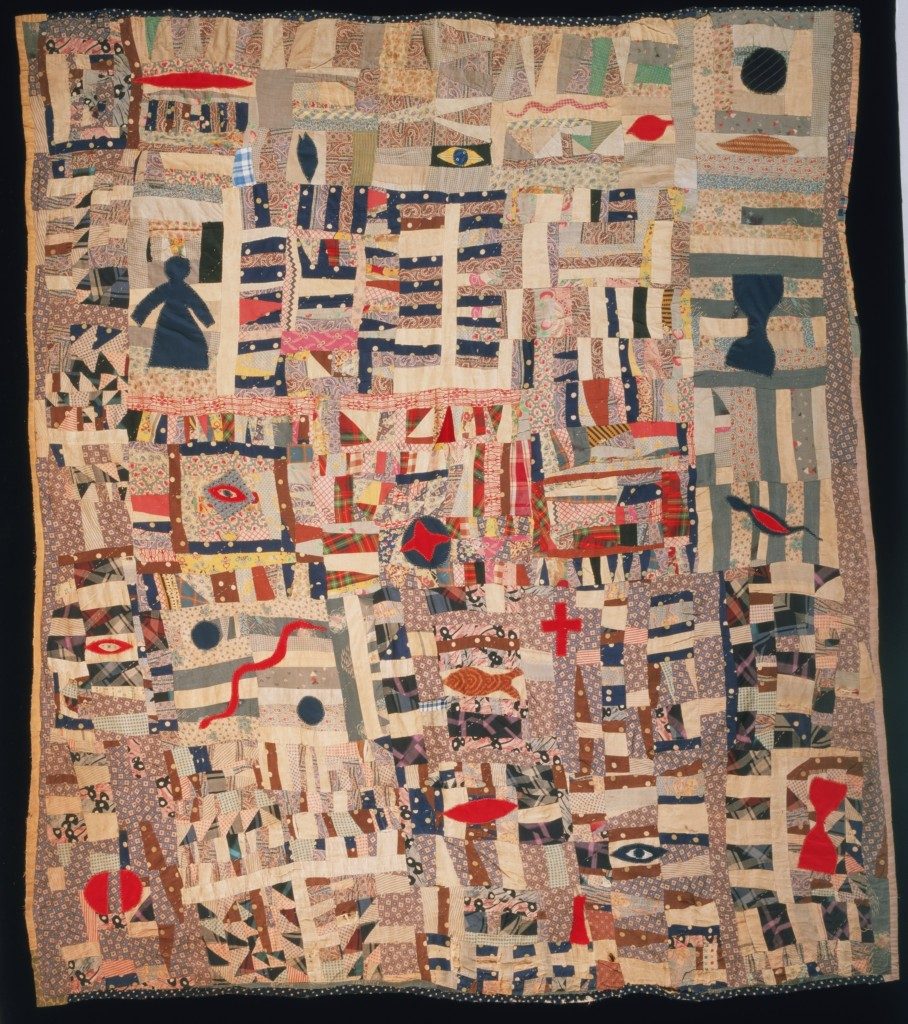
Brooker wakes up at five o’clock every morning to paint. He first began this daily schedule shortly after the birth of his first child in 1973. When he had to teach at night, he took care of his son, Musa, during the day. Working primarily during naptime, the artist remembers this as one of the most productive periods of his career, creating 150 works on paper and canvas a year for five years straight. Within his music-filled studios, at home or now in the converted nineteenth-century textile factory in Philadelphia, usually jazz or gospel music plays. He is able to metamorphose what starts off as a series of small drawings on paper into larger paintings on paper and canvas. Although his works may have the appearance of having been done quickly—frenetic long dashes of pastels across blocks and grids of oil or encaustic—they are actually the result of painstaking hours, days, and months of sketching, painting, and, at times, pensive looking.
In the context of Brooker’s upbringing in the black communities of South Philadelphia and his church, the artist’s philosophical and practical implementation of gospel and jazz music matches his sensibilities toward the ethereal luminescence of Tanner’s canvases and the formal abstract tenets of Kandinsky. Brooker admits that a formal language has consistently been in place for him. Notably, in most of his paintings, the frenzied, text-like lines overlaid on the blocks, bars, and splotches of color suggest a symbolic idiom through which the artist yearns to communicate with the viewer. He developed much of his vocabulary from those he calls “giants of the visual and performing arts,” namely Giotto, Hans Hofmann, Arshile Gorky, Arthur Beecher Carles, Cy Twombly, Sam Gilliam, Al Loving, Ray Saunders, and musicians Miles Davis, John Coltrane, and Charlie Parker, among others. While Brooker eventually moved away from Tanner’s figurative approach to religious painting, Wassily Kandinsky remains one of the most significant influences on his work and the artist to whom he turns for pictorial cues.
Kandinsky was one of the first artists to abandon recognizable subject matter toward a search for the mystical in art in the early twentieth century. As an artist trained in music, he actively pursued forming an ideology and subsequent language in visual art as a universal form of communication. He, along with Franz Marc, formed Der Blaue Reiter (The Blue Rider) group in Munich in 1911, using a name borrowed from one of Kandinsky’s paintings from 1903. The group modeled their language after the visionary language of the Book of Revelation with the expectation that art should only represent itself—a reference that might resonate with a P.K. While Brooker attended PAFA, his instructor Roswell Weidner encouraged him to read Kandinsky’s Point and Line to Plane, written in 1926.16 The book was “transformative,” Brooker recalled. “Reading it . . . and I still go back to it, for myself and when I teach . . . that’s when I went from being a realistic painter to an abstract painter.”17 While Kandinsky offered some analysis of the psychic qualities of color, as did other artists such as Josef Albers, I am interested here in the musical component that he applies to the visual arts.
In his book Concerning the Spiritual in Art, Kandinsky outlined his theories on the aesthetics of shape along with the psychology and language of color and form in painting, which made him one of the first European artists to break through the representational barrier into total abstraction. For Kandinsky, the breakdown of the figure-ground relationship, along with actively experimenting with color and line for its own sake, provided an unmatched, ecstatic spiritual fulfillment. Within his analysis, the “spiritual” is non-material, practically anything that cannot be touched by hand.18 In the section “The Psychological Working of Color,” Kandinsky proclaims, “Generally speaking, color is a power which directly influences the soul. Color is the key-board, the eyes are the hammers, the soul is the piano with many strings. The artist is the hand which plays, touching one key or another, to cause vibrations in the soul.”19 According to Kandinsky, colors have specific emotions and meanings attached to them depending on the hue and their placement next to different colors—the warmth or coolness of red may represent fire or anger or passion. In Brooker’s Kinda, Sorta (2006; fig. 7), blocks of red anchor the painting at the top and bottom of the frame, creating “motion within itself,” according to Kandinsky’s analysis of the “language of form and color.”20 Focusing on the highest part of the composition, the motion of the “hot” red cools and slows down the metaphysical viewing of the color as “flames” in contrast to the accompanying “cooling” effect of the lighter red and blocks of varying degrees of blue on either side, where “the gazer may seek relief” in the latter.21 Brooker’s study of early twentieth-century color theory rhymes well with his commitment to the spiritual resonances of painting by both Tanner and Kandinsky.
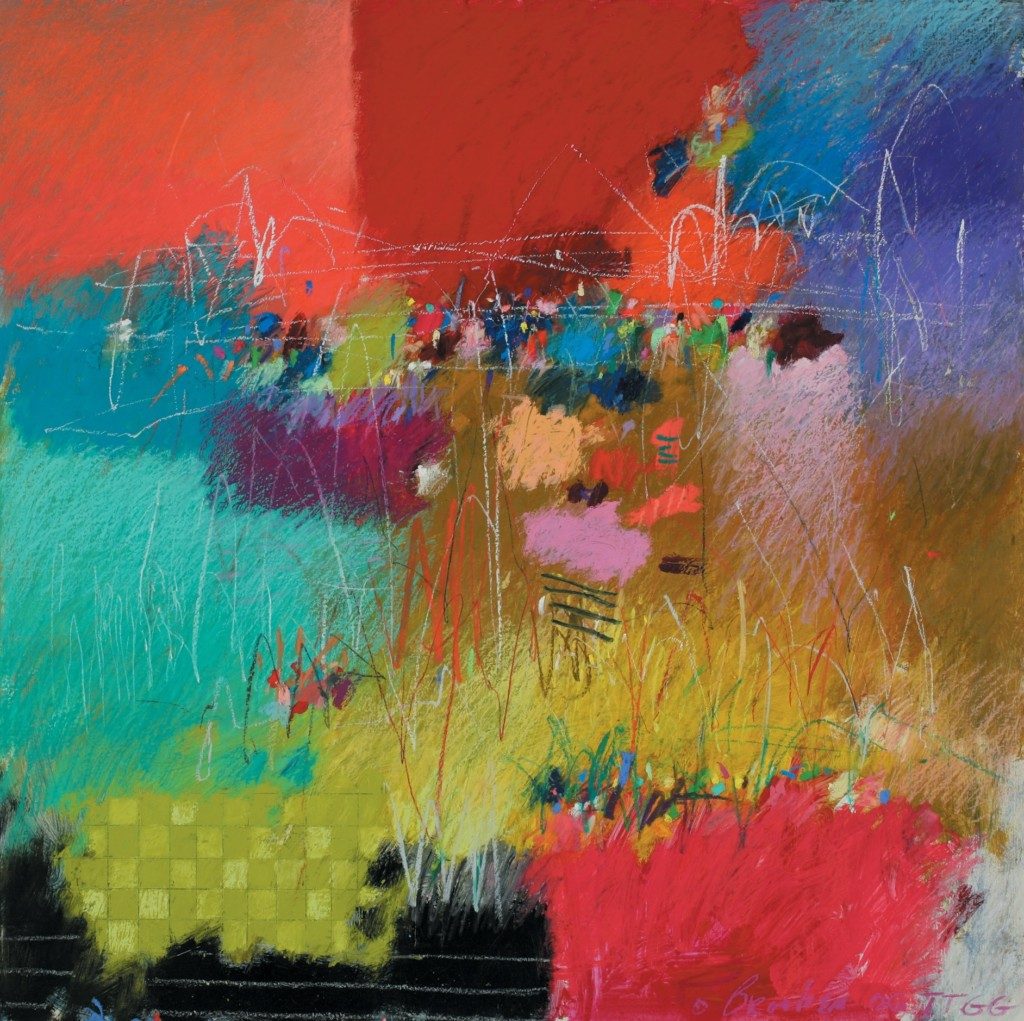
Tanner and Kandinsky served as artists who led and mentored aspiring artists through academic and spirit-driven pedagogy within European communities: in the Étaples art colony in Normandy and at the Bauhaus in Weimar Germany, respectively. Herein lies the even more fruitful connection between Tanner and Kandinsky for Brooker: they used painting to convey messages of the divine and to project specific temperaments that go beyond religion and ethnic heritage in order to engage the viewer into what art historian David Morgan calls “a sacred gaze.” Morgan defines the sacred gaze as “the manner in which a way of seeing invests an image, a viewer, or an act of viewing with spiritual significance.”22 A simultaneous aesthetic and mystical process, whether motivated by scripture or the pleasure of color or line, their marks on the canvas produced a hallowed exchange. Based on Morgan’s premise, Marcus Bruce discusses this custom within Tanner’s paintings, arguing that the artist “troubled the gaze” by creating a “contractual agreement between image or object and viewer, the acceptance of a particular representation as a form of knowledge and an accurate representation and construction of reality—the world in which people live.”23
Brooker served as professor and chair of the basics department at Moore College of Art and Design in Philadelphia before his retirement in 2015. He taught his students that consistent contact with the work allows for a transformation that is different than working on a work of art for extended hours and then taking a break for, say, two weeks. By his own example, he instructed his students to answer questions about their art that only habitual working can resolve. Brooker’s philosophy is: “Questions lead to search. Search leads to discovery. Discovery leads to adventure. For me, that’s the process that lets me grow constantly.” He is interested in the depth of the human spirit and “the unspeakable joy” found therein. Much like Kandinsky’s own, often moving descriptions of paintings in Concerning the Spiritual in Art, each painting for Brooker is intended to reflect “the love and excitement, the disappointment and sadness and nurturing [since] these are the many layers that exist in the human spirit.” Deeply interested in the materiality of oil, encaustic, collage elements, colored pencils, and pastels as they relate to one another, Brooker’s daily work and continuous layering, both physical and essentially metaphysical, provide many of his paintings with an unfathomable depth and movement between planes of color. Therefore, discoveries are only made because of the systems that become established as a result of daily work, the art-historical study and ritualistic attendance in the studio that, for someone like Brooker who is shaped by Tanner and Kandinsky, transforms into worship.
A holy meditation of sorts takes place in his studio. Brooker may have moved away from the church as a specific subject matter, but he nevertheless believes that his paintings are the result of contact with the divine. As he puts it, “painting is worship.” The painting process as a daily devotion for him, he asserts, is “almost like a prayer . . . and what passes through me is not of my own invention. It comes from the higher Being . . . It’s not church. This is my private worship.” For this reason, he signs each work of art, “TTGG” (To The Glory of God) in recognition of the godly power and privilege given him to paint. Regardless of the viewer’s receptivity to a Christian God, Brooker knows such a being exists for him and that his paintings should elicit a “sacred gaze.”
God is light. . . . I wasn’t looking for the light that comes from something, I was looking for the light contained inside. . . . God is light. The other important thing for me is that God is layers—The father, the son, and the holy ghost. . . . The combination of color, of light, and of layers, began to help me understand. And as that began to develop, the sense of music—which is linear in my mind—began to impact the image. So what began to happen is that a linear structure would be put down, then layers of color and layers of shape. And all of that I found relative to my perception of God, what he is and what he is to me.24
Therefore, when viewing Brooker’s paintings, one senses an ability to metaphorically dive into various layers of blocks and patterns of bright colors and shapes within a simultaneously vast and confined space, regardless of the size of the frame.
Brooker’s first opportunity to expand his worldview beyond the borders of the United States came after he was drafted to serve in Korea from May 1964 to September 1965. He also visited Japan while overseas, and his exposure to Buddhism and Christianity as practiced in both countries allowed him to see parallels in his own religious culture. Although their beliefs did not sway him, he engaged in conversations where he could express his thoughts about his understanding of faith. In Korean funeral rites, it is believed that there are three spirits of the deceased person:
After death the three spirits are separated from each other. One is carried to heaven or the other world. Another spirit stays in the body. The third spirit stays in the box for the spirit, the honback sangja, which is made of strings or paper.25
In contrast, Christian ideals of faith are based on what a follower cannot see. In evoking the biblical scripture from Hebrews 11:1, Brooker remarks, “How can you be sure of anything if you don’t see it, if you don’t touch it, if you don’t have some sense of it. . . . It’s believing in something that you can’t see, but you know when you feel its presence.”26 In Korea, family members would tend to the box of the spirit within a shrine, traditionally at home for two years, such that their ancestor spirits would live together with them in this world. The high visibility of the deceased and their spirits through their beautifully adorned, often quite colorful shrines are far more physically grounded and metaphysically encountered. Brooker realized then that “God is a personal experience.” His witnessing of these cultural and spiritual differences, most palpably in how one honors the death—and presence—of one’s ancestors, one’s spirit in a triplicate universe, could provide universal access to a transcendent realm. For Brooker, improvisation on the canvas through abstraction provides access to a sacred realm through experimentation with structure, which enhances his spiritual engagement with God through painting.
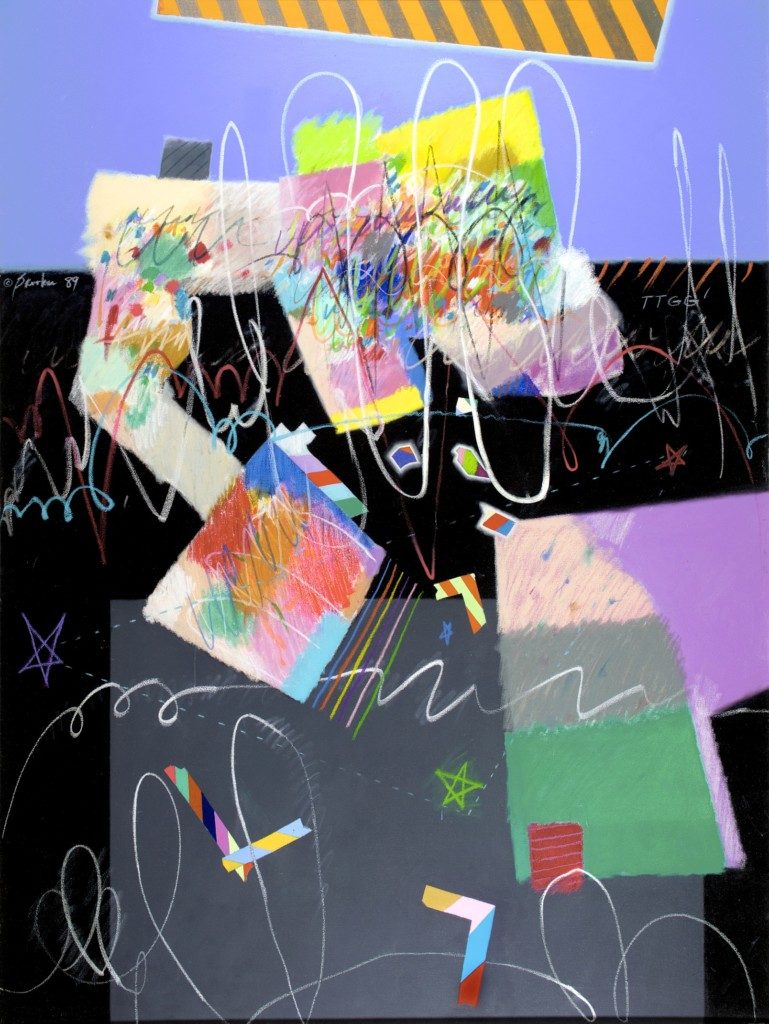
Brooker blends his interest in the spiritual and artistic work of Tanner and Kandinsky with his investment in jazz. His early abstractions included shapes, diagonals, bars, and the color black, that are still evident in his work today, but he no longer relies on the color black and he has rid his canvas of overt symbols such as stars (1989; fig. 8). Although he deliberately wants his artwork to look spontaneous, like a seemingly hurried graffiti tag or a painting on the side of a train or outdoor wall, the artist asserts that, like jazz, “spontaneity is not an impulsive choice. It is a form choice.”27 Artists, visual and musical, must get their vocabulary straight before they can proceed at the highest levels of proficiency to forge a unique way of approaching their own work.28
Taking the broadest of definitions available to encompass the multiple meanings and styles designated by the word “jazz,” the New Grove Dictionary of Jazz states the following: “A music created mainly by black Americans in the early 20th century through an amalgamation of elements drawn from European-American and tribal African musics.”29 Musicologist Portia K. Maultsby supports the assertion that the music itself combined the influences of the two cultural identities:
Because the tempered tuning of these Western instruments differed from that of African instruments, black musicians were forced to deviate from African principles of melodic structure. Challenged to explore new means of melodic expressions, blacks unconsciously created new ideas founded on existing African musical concepts. The result was the emergence of “blue notes” (flatted third and seventh degrees) and the production of pitches uncommon to Western scale structures.30
In other words, in jazz, African Americans created extensions of spirituals, or what W. E. B. Du Bois called “sorrow songs” in the Souls of Black Folk, which transformed the dominant forms of Western traditions into a distinctive African American sound and style.31
In jazz improvisation, one faces a number of challenges, such as learning how to start and stop solos, how to conceive and perform patterns in time, and how to gain mastery over the vocabulary and other materials required for any given piece of music. Brooker greatly admires the saxophonist Charlie Parker, namely because of his use of “substitute chords,” which he played and resolved in ways never heard before. Parker would choose musical steps based on what he was hearing and his accumulated musical knowledge, but he allowed for intuition to take over. As a result, Parker, along with a myriad of jazz professionals performing at Minton’s Café in New York, created a new sound, a new style.32 Similarly, Brooker was able to discover his own visual language by applying parallel principles brought together harmoniously as a product of his everyday reverence for God, with paint as the medium, as material, and as intercessor. Visually, there is a nearly literal, formal, quilt-making stitching of the planes of color, line, and shape (as outlined by Kandinsky) that merges with the various musical influences (Charlie Parker) that Brooker’s study has brought together harmoniously as a product of his daily devotion (as articulated by Tanner).
Moe A. Brooker’s energetic, abstract, mixed-media paintings are the direct result of his ongoing spiritual examinations and dedicated approach to making art. In Ancient Futures, Brooker paints to convey the resonances of the chords of orange beneath lavender, shifting under the blue-and-black chessboard; pastel blue dashes seaming black, orange, green, and ochre planes together; nodes of irregularly shaped circles from the whole color spectrum dancing in harmony with one another. He strives through soul-filled paintings to touch the human spirit. If his paintings are as multilayered and complex as the people who have the opportunity to encounter them, then like the son of a preacher—a true P. K.—he plays the keys, hoping to cause the vibration of the viewer’s soul. The artist does not ask that you like his work, but he does have one request: “I ask that you be changed by it.”33
Cite this article: Nikki A. Greene, “Vibrations in the Soul: Moe Brooker’s Sacred Paintings,” Panorama: Journal of the Association of Historians of American Art 4, no. 1 (Spring 2018), https://doi.org/10.24926/24716839.1631.
PDF: Greene, Vibrations in the Soul
Notes
- This essay has been significantly revised and expanded from the original: Nikki A. Greene, “The Art of Moe Brooker: Reflections of the Human Spirit,” in Moe Brooker: Carelessly Exact (Laurel, MS: Lauren Rogers Museum of Art, 2009). ↵
- Moe Brooker, interview by the author, July 23, 2009. All subsequent quotes by the artist derive from this interview and another interview by the author on January 18, 2012. ↵
- Pennsylvania Academy of the Fine Arts, Mark Hain and Alex Baker, eds., Pennsylvania Academy of the Fine Arts, 1805–2005: 200 Years of Excellence (Philadelphia: Pennsylvania Academy of the Fine Arts, 2005). ↵
- For the most recent overview of Henry Ossawa Tanner’s biography, see Anna O. Marley, “Introduction,” in Henry Ossawa Tanner: Modern Spirit (Philadelphia: Pennsylvania Academy of the Fine Arts in association with the University of California Press, 2012), 17–44. ↵
- Nilgun Anadulu Okur, “Underground Railroad in Philadelphia, 1830–1860,” Journal of Black Studies 25, no. 5 (1995): 538. ↵
- William Seraile, Fire in His Heart: Bishop Benjamin Tucker Tanner and The A.M.E. Church, first edition (Knoxville: University of Tennessee Press, 1998). ↵
- Henry Ossawa Tanner, “An Artist’s Autobiography,” The Advance 65, no. 2472 (March 20, 1913): 2014; and Robert Cozzolino, “‘I Invited the Christ Spirit to Manifest in Me’: Tanner and Symbolism,” in Henry Ossawa Tanner: Modern Spirit, 119. ↵
- Judith Wilson, “Henry O. Tanner’s ‘Lifting the Veil’: The Banjo Lesson and The Thankful Poor,” in Critical Issues in American Art: A Book of Readings, ed. Mary Ann Calo (Boulder, CO: Westview Press, 1998). For more on the history of the African Methodist Episcopal Church, see Richard S. Newman, Freedom’s Prophet: Bishop Richard Allen, the AME Church and the Black Founding Fathers (New York: New York University Press, 2008). ↵
- Albert Boime expands on Wilson’s argument by considering the impact his racial identity and institutionalized racism had on his career in France. See Boime, “Henry Ossawa Tanner’s Subversion of Genre,” The Art Bulletin 75, no. 3 (September 1993): 415–42. ↵
- Wilson, “Henry O. Tanner’s ‘Lifting the Veil,’” 200. ↵
- Suzanne Blier, Royal Arts of Africa: The Majesty of Form (New York: Harry N. Abrams, 1998), 152–54. ↵
- Brian Baade, Amber Kerr-Allison, and Jennifer Giacci, “Pursuit of Ideal Effect: The Materials and Techniques of Henry Ossawa Tanner,” in Henry Ossawa Tanner: Modern Spirit, 159. ↵
- Excellent resources on African American quilting traditions include Jacqueline Tobin and Raymond G. Dobard, Hidden in Plain View: The Secret Story of Quilts and The Underground Railroad (New York: Doubleday, 1999); and Eli Leon, Accidentally on Purpose: The Aesthetic Management of Irregularities in African Textiles and African-American Quilts (Davenport, IA: Figge Art Museum, 2006). ↵
- See Paul Arnett, Joanne Cubbs, and Eugene W. Metcalf Jr., eds. Gee’s Bend: The Architecture of the Quilt (Atlanta, GA: Tinwood Books, 2006). The exhibition was on view at the Philadelphia Museum of Art from September 16, 2008–December 14, 2008. Brooker visited the exhibition several times. He even attended a program where a few of the quilters performed gospel music in the galleries of the museum. Brooker, interview, 2009. ↵
- Brooker, interview, 2009. ↵
- Wassily Kandinsky, Point and Line to Plane, ed. Hilla Rebay, trans. Howard Dearstyne (New York: Dover Publications, 1979). Walter Gropius and Laszlo Moholy-Nagy first published the book under the title Punkt und Linie Zu Pläche as the ninth in the series of fourteen Bauhaus-edited books. The Solomon R. Guggenheim Foundation for the Museum of Non-Objective Painting New York City republished the edition in 1947. ↵
- M. English and For Digital First Media, “Artist Moe Brooker to Address Conshohocken Art League Reception,” The Times Herald, October 17, 2016, http://www.timesherald.com/article/JR/20161017/
NEWS/161019831. ↵ - Wassily Kandinsky, Concerning the Spiritual in Art, trans. Michael T. H. Sadler, rev. ed. (1911; London: Tate Publishing, 2006), 19–20n1. ↵
- Kandinsky, Concerning the Spiritual in Art, 25. ↵
- Kandinsky, Concerning the Spiritual in Art, 36–7. ↵
- Kandinsky, Concerning the Spiritual in Art, 24. ↵
- David Morgan, The Sacred Gaze: Religious Visual Culture in Theory and Practice (Berkeley: University of California Press, 2005), 4. ↵
- Marcus Bruce, “A New Testament: Henry Ossawa Tanner, Religious Discourse, and the ‘Lessons’ of Art,” in Henry Ossawa Tanner: Modern Spirit, 110. ↵
- Brooker, interview, 2009. ↵
- Soo-Young Kwon, “Grief Ministry as Homecoming: Framing Death from a Korean-American Perspective,” Pastoral Psychology; New York 54, no. 4 (March 2006): 316, http://0-dx.doi.org.luna.wellesley.edu/10.1007/s11089-005-0002-1. ↵
- Brooker, interview, 2012. ↵
- Brooker, interview, 2009. ↵
- I discuss in great detail my own theory (which could be applied to Moe A. Brooker) about how artists such as Romare Bearden employ jazz structures as visual tools to represent different facets of black American life during the twentieth century in Nikki Greene, “Riffing the Index: Romare Bearden and the Hand of Jazz,” in Music, Art and Performance from Liszt to Riot Grrrl, ed. Diane Silverthorne (London and New York: Bloomsbury Press, 2018), 183–201. ↵
- Barry Kernfield, ed., New Grove Dictionary of Jazz, First Edition, vol. 1 (London: MacMillan; New York: Grove’s Dictionary of Music, 1988), 580. ↵
- Portia K. Maultsby, “Africanisms in African-American Music,” in Africanisms in America, ed. Joseph Holloway (Bloomington: Indiana University Press, 1990), 187. ↵
- W. E. B. Du Bois, “Chapter XIV: The Sorrow Songs,” The Souls of Black Folk, (Chicago: A.C. McClurg, 1903), in The Oxford W.E.B. Du Bois Reader, ed. Eric J. Sundquist (New York: Oxford University Press, 1996), 230–240. ↵
- Many consider Parker’s recording of “Koko” on November 26, 1945, at Savoy Records in New York City to be the first recorded sounds of bebop. One must not overlook how transformative these new sounds were post-World War II, when people of African descent in the United States were mounting the “Double V” campaign: victory abroad and victory at home for soldiers faced with the dilemma of being deemed good enough to fight for the United States, but otherwise facing daily hardship back home due to racial discrimination. See Eric Lott, “Double V, Double-Time: Bebop’s Politics of Style,” Callaloo no. 36 (Summer 1988): 597–605. ↵
- Brooker, interview, 2009. ↵
About the Author(s): Nikki A. Greene is Assistant Professor of Art at Wellesley College.

